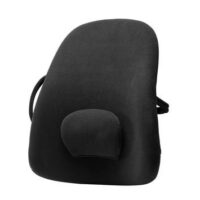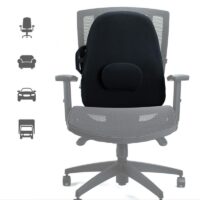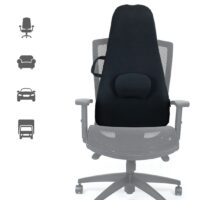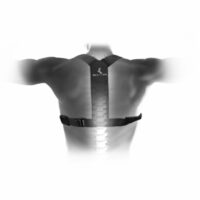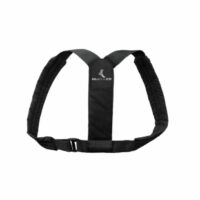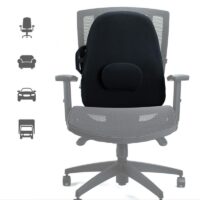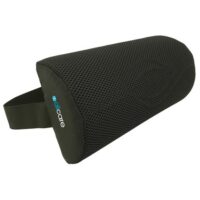Posture Correction
Article by John Miller


Posture Correction
Unlock Your Posture Potential
You’re not stuck with bad posture forever! Understanding your postural habits can change your posture at any age. Your body’s tissues, capable of renewing and adapting, are key. Younger folks might adapt quicker due to faster tissue renewal, but older individuals can still make significant gains. Even if you can’t completely reverse postural changes, slowing down age and habit-related deterioration is a big win.
The Role of Posture Correction Tools
In cases of pronounced muscle fatigue, tools like posture braces and supports, correctors, exercises, and taping come in handy. They act as reminders, helping your body shift towards better posture.
Do Posture Braces Really Work?
Posture braces are especially useful in the early stages of postural training. They provide control for the lower back, upper back, and shoulders. As your posture improves, you can move from heavier braces to lighter ones, and eventually, kinesiology taping can be enough to maintain perfect posture.
Kinesiology Tape for Posture
Kinesiology taping is a minimalist approach, ideal when slight posture correction is needed. It serves as a subtle reminder, aiding your transition from heavier support braces to normal posture.
Support for Upper Back & Shoulders
Upper back and shoulder braces are fantastic during the initial phase of posture correction. They enhance your awareness of correct posture. Wearing these braces for a few hours daily trains your body to recognise and maintain proper posture.
Lower Back Postural Braces: The Foundation
Good posture starts from the base. Lower back sitting cushions are essential. They help rectify long-standing poor postural habits and reacquaint your body with the sensation of normal posture.
Sitting Posture Support Devices
To improve your sitting posture, use passive aids like cushions. These devices support you while your postural muscles gain strength, perfect for preventing short-term and long-term slouching.
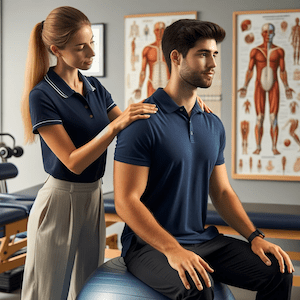
Exercise Ball: More Than Just Exercise
Exercise balls aren’t just for workouts; they’re great for retraining postural muscles when used as a chair alternative.
Spine Mobilisation Equipment
A stiff spine can be a roadblock to good posture. Physiotherapists can target specific stiff areas, and you can also assist this process at home with spine mobility equipment. There is also home DIY tools that may assist.
Sleep Posture Matters
Don’t ignore your sleeping posture. A supportive pillow and mattress are crucial for both good sleep and spine support.
Conclusion: Take Charge of Your Posture
Improving your posture is a journey that needs patience and consistency. The right tools and practices can make a significant difference. But, for personalised advice, consult a professional physiotherapist specialising in posture correction.
Seek Professional Advice
Always consider seeking the advice of a qualified physiotherapist for tailored recommendations and to keep up with the latest research in posture correction.
This article serves as a guide to understanding the importance of posture correction and is not a substitute for professional advice.
Rochedale - Call 38410277
Book Online: RochedaleSalisbury - Call 32751044
Book Online: SalisburySandgate - Call 32691122
Book Online: SandgateArticle by John Miller
Posture FAQs
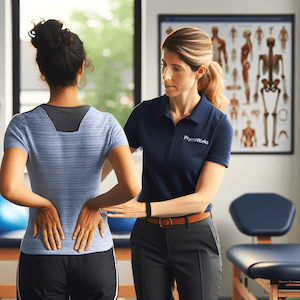

Your Guide to Better Posture
Maintaining good posture is crucial for overall health and well-being. Poor posture can lead to a host of issues, including back pain, reduced mobility, and even long-term health problems. This FAQ page addresses common questions about posture, providing insights and tips to help you improve your posture and enhance your quality of life.
Why is Good Posture Important?
Good posture helps you stand, walk, sit, and lie in positions that place the least strain on supporting muscles and ligaments. It keeps bones and joints in correct alignment, reducing the risk of injury and discomfort. Learn more about the benefits and reasons for maintaining good posture in the following articles:
- Why Posture Matters: Discusses the significance of good posture and its impact on overall health.
- Health Benefits of Good Posture: Explains the various health benefits of maintaining correct posture.
- Posture and Pain Prevention: Highlights how good posture can prevent common aches and pains.
How to Improve Your Posture?
Improving your posture involves strengthening the muscles that support your spine and developing new habits for standing, sitting, and lying down. Here are some practical steps and exercises to help you improve your posture:
- Posture Exercises: A list of exercises specifically designed to improve posture.
- Tips for Better Posture: Practical tips and techniques to incorporate into your daily routine.
- Ergonomic Advice: Guidance on how to set up your workspace and living areas to support good posture.
What Are the Effects of Poor Posture?
Poor posture can lead to various negative health outcomes, including chronic pain, reduced flexibility, and even respiratory issues. Understanding these effects can motivate you to make positive changes:
- Consequences of Poor Posture: Details the health risks associated with poor posture.
- Posture and Back Pain: Explains the connection between poor posture and back pain.
- Posture and Overall Health: Discusses how poor posture affects various aspects of your health.
Who Can Help with Posture Improvement?
Physiotherapists are trained to assess posture and develop customised treatment plans to improve it. Learn more about how a professional can help:
- Physiotherapy for Posture Improvement: Explains the role of physiotherapy in enhancing posture.
- Choosing the Right Physiotherapist: Fnding a physiotherapist who has a special interest in posture correction.


Conclusion
Improving and maintaining good posture is essential for your overall health. By following the tips and exercises provided, you can reduce pain, enhance your physical performance, and prevent future health problems. If you need professional help, don't hesitate to consult a physiotherapist.
Rochedale - Call 38410277
Book Online: RochedaleSalisbury - Call 32751044
Book Online: SalisburySandgate - Call 32691122
Book Online: SandgatePosture FAQs
- Why is good posture important? Good posture keeps bones and joints in correct alignment, reducing the risk of injury, pain, and long-term health problems. It also improves breathing and circulation.
- How can I improve my posture? You can improve your posture by doing specific exercises, being mindful of your body positions, and setting up an ergonomic workspace. Regular check-ups with a physiotherapist can also help.
- What are the signs of poor posture? Common signs include rounded shoulders, a forward head position, and back or neck pain. You may also experience fatigue and reduced flexibility.
- Who can help me with my posture? A physiotherapist can assess your posture and create a personalised treatment plan. They can teach you exercises and techniques to improve your posture.
- Where can I find resources to improve my posture? Resources are available on the PhysioWorks website, including articles on posture exercises, tips for better posture, and ergonomic advice.
- When should I seek professional help for my posture? If you experience persistent pain, discomfort, or find it challenging to maintain good posture on your own, consult a physiotherapist.
Follow Us for Free Tips
Stay updated with the latest tips on posture and overall health by following us on our social media platforms. We regularly share practical advice, exercises, and health information to help you maintain good posture and improve your well-being. Don't miss out on valuable insights!
Related Articles
- Back Pain – Causes, Treatment & Prevention Discover the common causes of back pain and effective treatment options.
- Neck Pain – Causes, Treatment & Prevention Learn about neck pain causes and how to treat and prevent it.
- Ergonomics: How to Set Up Your Workspace Tips for creating an ergonomic workspace to support good posture.
- Core Strengthening Exercises for Better Posture Strengthening your core can significantly improve your posture.
- Lumbar Support: Benefits and Best Products Explore the benefits of lumbar support and top product recommendations.
- Yoga for Posture Improvement Incorporate yoga poses into your routine to enhance your posture.
- Pilates for Posture Correction Pilates exercises that focus on posture correction and alignment.
- The Importance of a Proper Mattress for Posture How choosing the right mattress can support your spine and improve posture.
- Tips for Reducing Desk Job-Related Posture Issues Address common posture issues related to long hours at a desk job.
- Stretching Routines to Improve Flexibility and Posture Incorporate stretching routines to enhance flexibility and support better posture.
- Mayo Clinic: Posture Matters: Explains the importance of good posture and how to achieve it.
- Harvard Health: Tips to Improve Your Posture: Offers practical tips for better posture.
- WebMD: The Importance of Posture: Discusses why posture is crucial and how to maintain it.
Each of these articles provides valuable insights and practical tips to help you maintain and improve your posture, ensuring you stay healthy and comfortable.
Posture Improvement Products
Effective Management of Upper Back Pain and Injury
Physiotherapy Insights
Introduction
Upper back pain and injury, predominantly affecting the thoracic spine, are prevalent issues causing significant discomfort and impacting daily activities. This article, infused with physiotherapy insights, aims to enlighten the general public about the causes, symptoms, and treatment options for upper back pain.
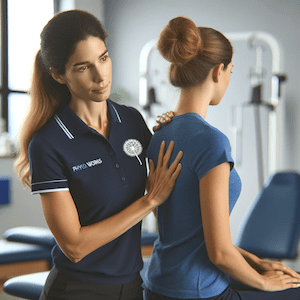

Managing Upper Back Pain
Upper back pain stems from various sources, including thoracic spine conditions, joint injuries, muscle strains, nerve irritations, and systemic diseases. Recognising these causes is vital for appropriate treatment.
Common Causes of Upper Back Pain
- Joint Injuries: Facet joint pain is a frequent issue.
- Muscle-Related Injuries: This includes back muscle pain, side strains, whiplash, muscle cramps, and DOMS (Delayed Onset Muscle Soreness).
- Bone-Related Injuries: Conditions like Scheuermann's Disease, Scoliosis, and others.
- Disc-Related Injuries: Including bulging, slipped, or herniated discs.
- Nerve-Related Pain: Such as thoracic outlet syndrome and pinched nerves.
- Systemic Diseases: These include Ankylosing Spondylitis, Fibromyalgia, and arthritis types.
Posture and Upper Back Pain
Poor posture is a significant contributor to upper back pain. Understanding and correcting sitting, standing, and sleeping postures can prevent and alleviate pain.
Physiotherapy Perspective
A physiotherapist's approach to treating upper back pain involves assessing the individual's condition and tailoring a treatment plan. This may include exercises, manual therapy, and advice on posture correction.
Latest Research and Techniques
Recent advancements in physiotherapy have introduced innovative methods for treating upper back pain. These include targeted exercises, advanced manual techniques, and utilisation of posture-improving products.
What to Do?
If you experience upper back pain, it's crucial to consult a physiotherapist for a professional assessment and personalised treatment plan.
Conclusion
Upper back pain, though common, can be effectively managed with the right approach. Understanding its causes and seeking professional physiotherapy advice are key steps towards recovery.
For more information, explore articles at PhysioWorks.
Related Articles
Joint Injuries
Muscle-Related Injuries
Bone-Related Injuries
Disc-Related Injuries
Nerve-Related / Referred Pain
Systemic Diseases
Posture Information
- Posture Syndromes
- Posture Improvement: A Guide to Improve Your Posture
- Improving Your Posture: A Guide for Better Health
- How to Achieve Perfect Posture











